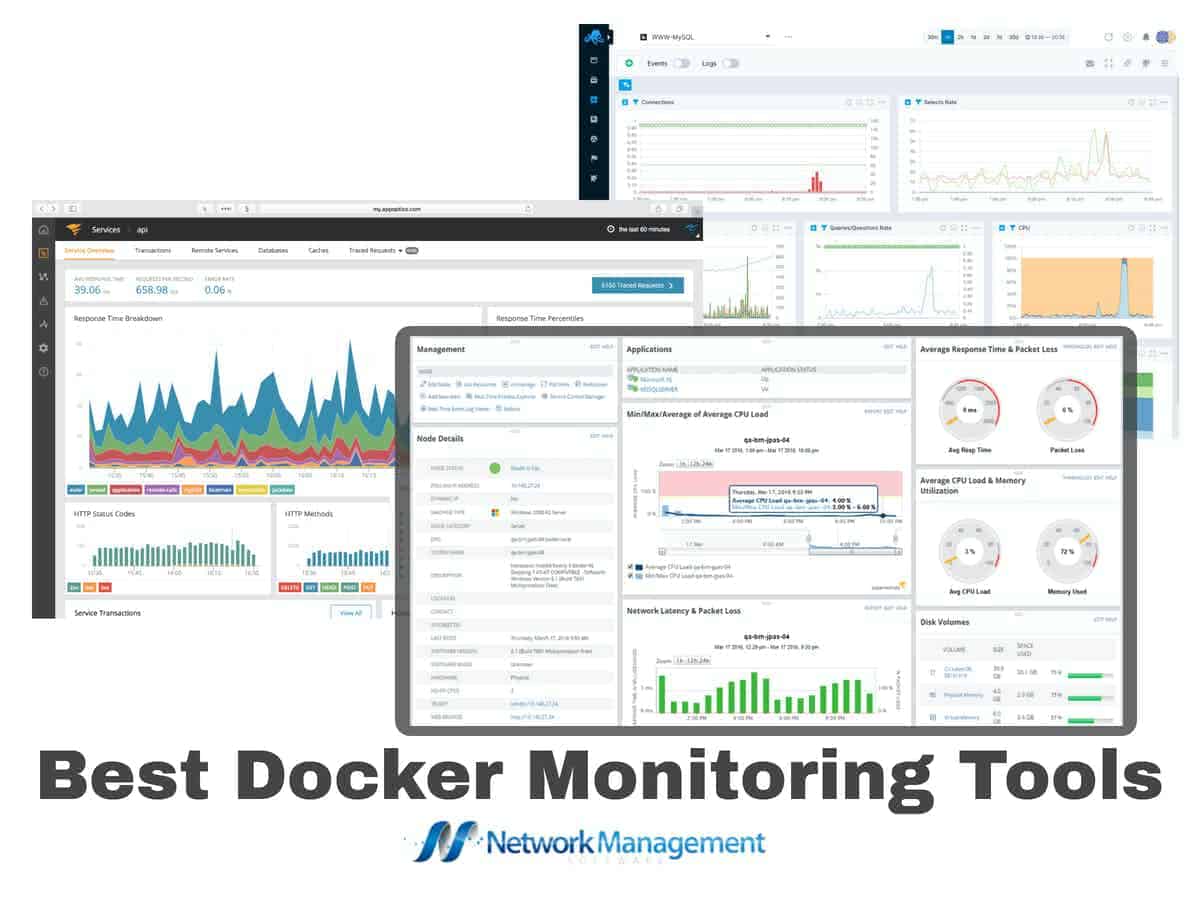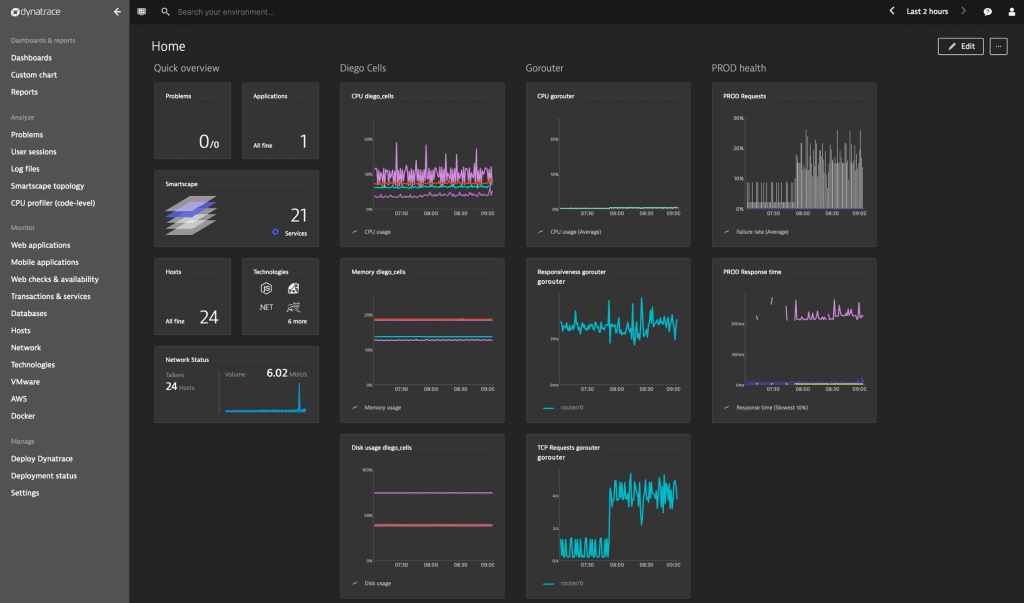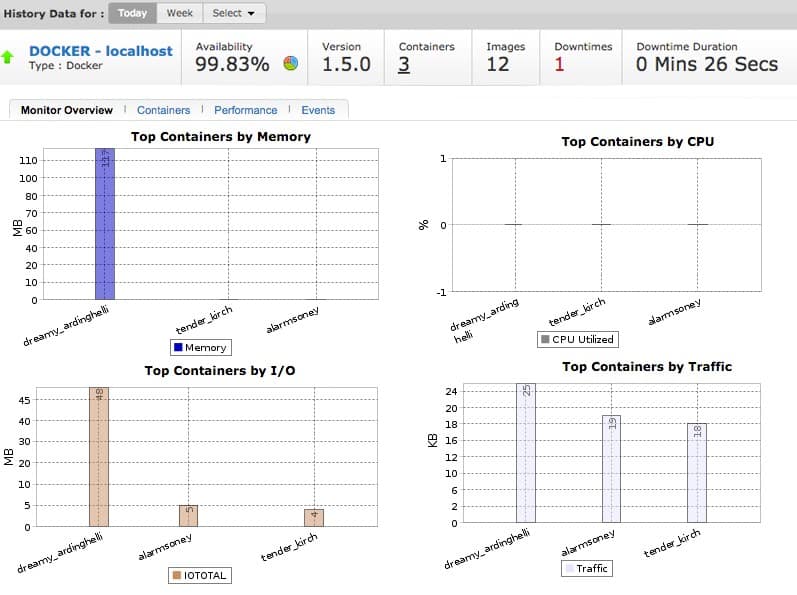
A monitoring system helps the DevOps team to detect and find the solution to any performance issue conveniently. With Kubernetes and Docker on a steady rise, it’s essential to get log management and container monitoring right from the beginning.
This is no easy work. Monitoring Docker containers is a highly complex task, as you need first to develop a strategy and then build a proper monitoring system. In this post, we will discuss intensely what container monitoring is about and why it is needed. We will also compare the best container monitoring tools of the market.
Here is our list of the ten best Docker Monitoring Tools:
- SolarWinds Server & Application Monitor – FREE TRIAL Enables you to monitor Docker containers. Depending on the environment you choose, it gives you a complete understanding of the Docker metrics and the Linux and Windows metrics. Start a 30-day free trial.
- AppOptics Docker Monitoring – FREE TRIAL A full-stack APM that allows you to figure out the performance of your application and lets you see your containers’ resources as well. Start a 30-day free trial.
- ManageEngine Applications Manager – FREE TRIAL Αn APM feature with native help for Docker Monitoring. It lets you quickly find and resolve performance issues across your whole application stack, from the link to the code link. Start 30-day free trial.
- Site24x7 Docker Monitoring – FREE TRIAL This package provides Docker container monitoring as part of a full-stack monitoring platform that is delivered from the cloud. Get a 30-day free trial.
- Sematext An excellent solution for Docker Monitoring. Sematext Monitoring is a full-stack detectable solution with the ability of Docker monitoring.
- Datadog Comes with a robust monitoring system for your applications, infrastructure, network, and logs. It also offers support for Docker containers.
- Sysdig Lets you enhance the performance and availability of your infrastructure, applications, and services.
- Dynatrace Α complete observability solution that gives you a user-friendly approach to Docker monitoring of your container’s metrics and logs.
- cAdvisor Αn open-source metrics collector built by Google to examine and expose usage and performance data of your resources from running containers.
- Sumo Logic Integrates containers that enable you to troubleshoot and do the root cause analysis of problems from distributed container-based apps and the Docker containers.
- Splunk Helps you with Docker Monitoring from host to container to application on just a single dashboard.
We are here to talk about the tradeoffs between using SaaS tools and CNCF products so you can make a proper estimate of your expenses and needs.
But before that, let us quickly give you an overview of the basics of Docker Monitoring.
What is Container Monitoring?
Container Monitoring is a straightforward process of checking the performance of your apps built on Microservice-architectures by collecting and analyzing the performance metrics of your application. Due to their temporary nature, the containers are tough to monitor as compared to the old apps.
In simple words, containers are temporary, which means stateless. Therefore, you must collect the metrics and logs and then immediately send them to some centralized location to keep them safe. Or else, they’ll be deleted when you delete the container. This is precisely why it’s more complicated and challenging than regular servers.
Why do you need to monitor Docker Containers?
Container Monitoring in the flesh is essential to make sure your app’s performance is at its peak. But when it’s about Docker containers, here is what monitoring helps you with:
- Discover and solve problems proactively, so you don’t face any risks in production.
- Make changes timely and safely while the entire environment gets monitored.
- Optimize resource allotment.
- Acceptable applications to deliver better performance and user experience.
How does Container Monitoring work?
Container Monitoring is not different from monitoring other old deployments as you need metrics, logs, health checks, and service discovery in both of them.
Still, container monitoring is more complicated because of its multi-layered and dynamic nature. But a friendly solution of container monitoring can help you through all its layers quickly. You just have to choose the best tool that fits your case precisely.
Here is the list of the ten best Docker Monitoring tools you should know about.
The Best Docker Container Monitoring Tools
1. SolarWinds Server and Application Monitor – FREE TRIAL
SolarWinds Server & Application Monitor top spot enables you to monitor Docker containers. Depending on the environment you choose, it gives you a complete understanding of the Docker metrics and the Linux and Windows metrics.
With supported out-of-the-box alerting and dashboarding ability, this is the best choice for docker monitoring and monitoring your complete infrastructure.
Download: Start a 30-day free trial.
2. AppOptics Docker Monitoring – FREE TRIAL
AppOptics is a full-stack APM that allows you to figure out the performance of your application and lets you see your containers’ resources as well. Through AppOptics, you can spot any performance issues immediately and know if they’re happening because of the containers of the running code.
AppOptics is also a part of SolarWinds now. As a result, all the SolarWinds Server & Application Monitor top spot features are now available on AppOptics. In addition, you can have an out-of-the-box Docker integration with significant usage of metrics to give you the required performance insights.
The alerts can also be configured to send them automatically when your Docker metrics are more than the limit set.
Download: Start a 30-day free trial.
3. ManageEngine Applications Manager – FREE TRIAL
ManageEngine Applications Manager is an APM feature with native help for Docker Monitoring. It lets you quickly find and resolve performance issues across your whole application stack, from the link to the code link. You get access to VMs, servers, and databases, on-premises and in the cloud as well.
This tool is the best one for all your monitoring and server requirements. It offers proactive and quick application docker monitoring services to measure the performance statistics for monitoring your infrastructure in real-time.
Unlike other monitoring tools, ManageEngine Applications Manager supports a wide range of over 100 famous technologies across different VMs, servers, application servers, containers, middleware and messaging components, web servers, and services, databases, etc.
ManageEngine Applications Manager’s monitoring tool can measure up to 10,000 apps with easy setup of the application monitor, without any training or consultation. Get a 30-day free trial.
4. Site24x7 Docker Monitoring – FREE TRIAL
Site24x7 Docker Monitoring is provided from a SaaS platform. The Site24x7 service packages its modules into plans that give you network, server, application, service, and middleware monitoring all tether for one subscription payment.
Docker Monitoring automatically identifies each container as it is created and registers it for performance tracking.
The performance monitoring feature records the resource usage of each container over its lifespan. The service tracks CPU and memory usage and network activity, which includes a byte count for inbound and outbound traffic.
It is possible to issue controls from the Site24x7 console to start and stop each container.
The Site24x7 system is able to track Docker activity on premises and on cloud platforms. While tracking the containers, it also watches the servers and platforms that support them.
The Site24x7 package is available for a 30-day free trial.
5. Sematext

Sematext Monitoring is an excellent solution for Docker Monitoring. Sematext Monitoring is a full-stack detectable solution with the ability of Docker monitoring.
It provides accessible set-up monitoring dashboards for events, logs, and metrics, giving you insights into your containers and the infrastructure.
With anomaly alerting, detecting, and correlations between all the different parts of your infrastructure, containers, and clusters, you have access to everything required in one place for faster and better troubleshooting.
You get full access and insights into your infrastructure. It doesn’t matter what platform you’re using or whether it’s VMs, bare metal, or a container environment like Rancher, Kubernetes, or Docker Swarm.
Mixing these features with alerts and anomaly detection to use different notification destinations provides a complete platform for observability.
6. Datadog

Datadog comes with a robust monitoring system for your applications, infrastructure, network, and logs. It also offers support for Docker containers.
All that you need to do is to install the Datadog agent. If you already have it installed, then you’re good to go. But if you don’t have it, just install the agent package and follow the guidelines. The only thing you need to think about is that the default limit of docker monitoring is 350 metrics per instance. So you can just collect Docker logs automatically if you want complete access to your container’s visibility.
7. Sysdig

Sysdig lets you enhance the performance and availability of your infrastructure, applications, and services. In addition, it gives you clear access to quickly changing your container’s environment.
You can solve the issues quicker by using container data from system calls that are enhanced with the Kubernetes context. In addition, Sysdig makes it easier for you to unify data across different teams for docker monitoring.
Sysdig is the first available monitoring platform that is compatible with Prometheus entirely. It gives the developer a familiar tool without the management issue. Sysdig can measure up to millions of metrics with long-term holding and only one backend. How Impressive.
8. Dynatrace

Dynatrace is a complete observability solution that gives you a user-friendly approach to Docker monitoring of your container’s metrics and logs.
It is available in software as a service (SaaS). Most of your Docker monitoring requirements, including its logs and the infrastructure it is working on, will be fulfilled by this tool.
Dynatrace allows you to explore container resource usage of different hosts. You also have access to some Docker metrics like RSS, CPU usage, and the total amount of time that a container’s CPU usage was attacked.
9. cAdvisor

cAdvisor, also known as Container Advisor, is an open-source metrics collector built by Google to examine and expose usage and performance data of your resources from running containers.
It is quoted by Github Repository that: “cAdvisor (Container Advisor) provides container users an understanding of the resource usage and performance characteristics of their running containers”.
In simple words, this states that cAdvisor works as a daemon and collects, processes, and exports data about containers. It keeps the data of isolation parameters and network statistics for every single container. This data is then exported by container throughout the machine.
10. Sumo Logic

One of the best docker monitoring systems is Sumo Logic. It has more than 150 apps and integrations to make it easy for you to sum up your data across your stack.
Sumo Logic integrates containers that enable you to troubleshoot and do the root cause analysis of problems from distributed container-based apps and the Docker containers.
You have a native collection source for the whole infrastructure, with real-time monitoring including events, stats, the ability to troubleshoot problems, container logs, and sets alerts on unusual application or container behaviors.
Then, you can visualize the date with your customized dashboards and gain visibility throughout your infrastructure.
11. Splunk

Splunk helps you with Docker Monitoring from host to container to application on just a single dashboard. You can easily see the infrastructure metrics and compare the performance of a single host to the whole population.
You can also relate performance metrics to a particular container and know if it has impacted your app at the service level.
Splunk collects various data about infrastructure, logs, and applications. You also get the discovery of Kubernetes components which lets you monitor the whole stack instantly.
How to choose the right tool for yourself
There are some open-source observability tools of containers for monitoring, logging, and tracing that are available. They all do the job well, and it’s up to you to pick out the best one according to your requirements and the amount of effort you want to put into the maintenance.
If you require observability, you will have to invest time into picking out the most valuable tools, learning how to use all of them, and finally install, maintain and configure them. Therefore, it would be wise to compare multiple tools and check how well different tools work together. Here’s how we suggest picking out the best docker monitoring tool for your usage.
- Coverage of log formats A typical app stack contains multiple components, including databases, message queues, web servers, etc. Make sure your apps enable you to structure logs. There are some ways of keylogging that you can follow if you’re planning to use your logs for troubleshooting and deriving insights from them. Defining log patterns with usual expressions takes a lot of time. However, this is a time-saver, especially in the world of containers when you use docker images.
- Coverage of collected metrics Some tools only gather a few metrics, and some collect a lot of metrics, which may not be of any use to you, while some tools allow you to configure which metrics are helpful for you. Not picking out valuable metrics can be frustrating when working under pressure to solve an issue related to production. Having the wrong metric or many of them will make it hard to locate signals that matter. Tools that need configuration to collect or visualize each metric take time to set up and maintain. Don’t use such tools. Instead, look for the ones that give you excellent freedom to customize the collection of your metrics.
- Detect and correlate metrics with the same behavior When metrics have similar behavior, we find one of the metrics typically is the leading cause of a performance jam. A perfect example we know about is high CPU usage corresponding with disk IO and swap activity. In this case, CPU usage and disk IO could be reduced by turning off swapping for the containers. The relation is known chiefly for system metrics above, but when you track your app-specific metrics, you can find new correlations and jams in your microservices that you will have to optimize later.
- Correlation of metrics, logs, and traces Whether you spot a problem initially through metrics, traces, or logs, having access to the complete observability data makes analyzing quick and easy. A single UI displaying data from many different sources is the key for fast troubleshooting and makes the DevOps’ job better and more enjoyable.
- Collection of events Any sign of why a service crashed or was restarted will help you know the problems quickly and get to the primary cause easily. Any container monitoring tool should collect Docker events then.
- Machine Learning abilities and anomaly detection for alerting on metrics and logs Alerts based on Threshold work fine only for the known and consistent workload. Threshold-based alerts create a lot of noise in dynamic environments. You need to make sure the tool you select has this ability and that it doesn’t require ages to know the baseline or need too much training or such.
- Single sign-on It is impossible to store Correlating data in silos. Also, using many services often needs multiple accounts, learning various services and their Uls, etc. Every time you use any of them, there is the painful overhead of adjusting anything like the time range just before you can check your data in them. This requires time and money and makes it complicated to share data with your team.
- Role-based access controlLack of RBAC will be a show-stopper for any tool that seeks adoption at the level of corporate. Tools that work nicely for teams with fewer members and SMBs, but don’t have proper multi-user support with their roles, and the permissions never meet the requirements of huge companies.
- The total cost of ownership
- While planning the setup of monitoring, people mostly underestimate the quantity of data caused by monitoring agents.
- Most companies underestimate the resources required for processing and retrieval of metrics and logs when their volume increases.
- An issue that companies commonly face is underestimating the effort of people and the investment of time required for the maintenance of monitoring open-source tools and infrastructure. This not only causes the cost for monitoring and logging to go over anyone’s expectations but also increases the time. Thus more money is required for the maintenance of the infrastructure.
- You can reduce it by limiting any data retention. This needs fewer resources, less experience to work on the infrastructure and tools, and less maintenance, but it limits the access and insights derived from long-term data.
- Another thing that works is lessening the granularity of metrics from an exact 10 seconds to a minute. This method is known as sampling. However, this can lead to other issues like having inaccurate information with less time to analyze problems and limited insight into the issues.
- You can avoid these problems entirely by picking a SaaS tool that does everything for you. Then, the only thing you have to do is send the data, and you will be able to sleep at night with no worries.
- Microservices transaction tracing
- Till now, we’ve only talked about monitoring and logging, ignoring the term Microservices transaction tracing as the third part of observability.
- Remember that the amount of data will increase as soon as you start gathering transaction traces in microservices. This leads to an increase in the total cost of ownership of a monitoring setup.
Conclusion
No matter how many Docker containers you’re working on, monitoring them is the best way to keep your app in progress and its users satisfied. Therefore, DevOps engineers need proper monitoring, tracking, and logging solutions with advanced functions like correlating traces, metrics, and logs.




